Margaret of France (1553–1615)
| Margaret of France | |
|---|---|
|
Detail of painting by Pieter Paul Rubens | |
| Queen consort of France | |
| Tenure | 2 August 1589 – 17 December 1599 |
| Queen consort of Navarre | |
| Tenure | 18 August 1572 – 17 December 1599 |
| Spouse | Henry IV of France |
| House | House of Valois |
| Father | Henry II of France |
| Mother | Catherine de' Medici |
| Born |
14 May 1553 Château de Saint-Germain-en-Laye |
| Died |
27 March 1615 (aged 61) Hostel de la Reyne Margueritte, Paris |
| Burial | Basilica of St Denis |
| Religion | Roman Catholicism |
Margaret of France (French: Marguerite, 14 May 1553 – 27 March 1615) was Queen of France and of Navarre during the late sixteenth century. A royal princess of France by birth, she was the last of the House of Valois.
She was the daughter of King Henry II of France and Catherine de' Medici and the sister of Kings Francis II, Charles IX and Henry III and of Queen Elizabeth of Spain. She was queen twice for she had married King Henry III of Navarre who finally became King Henry IV of France.
Margaret, among other political manipulations, was subjected to an arranged marriage and being held prisoner (albeit at a castle) for many years. However, her life was anything but passive.
Aside from being twice a queen—first of Navarre (1572), then of France (1589), Margaret was famous for her beauty and sense of style (she was one of the most fashionable women of her time, influencing most of Europe's Royal Courts with her clothing). She was also a gifted poet and writer, notable for both her own scandalous behavior and for revealing that of others. Margaret took many lovers both during her marriage and after her annulment. The most well-known were Joseph Boniface de La Môle, Jacques de Harlay, Seigneur de Champvallon and Louis de Bussy d'Amboise. When imprisoned by her brother Henry III for eighteen years, she took advantage of the time to write her memoirs, which included a succession of stories relating to the disputes of her brothers Charles IX and Henry III with her husband Henry IV. The memoirs were published posthumously in 1628.
Her life has inspired a variety of stories over the centuries, beginning with Shakespeare's early comedy Love's Labour's Lost written during her lifetime, to Alexandre Dumas, père's 1845 novel La Reine Margot; to a 1994 movie La Reine Margot.
Life
Early life
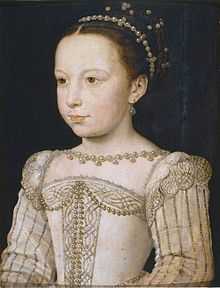
Margaret was born Marguerite de Valois on May 14, 1553, at the royal Château de Saint-Germain-en-Laye, the seventh child and third daughter of Henry II and Catherine de' Medici.[1] Three of her brothers would become kings of France: Francis II,[1] Charles IX[1] and Henry III. Her sister, Elisabeth of Valois, would become the third wife of King Philip II of Spain. In 1565, her mother Catherine met with Philip II's chief minister Duke of Alba at Bayonne in hopes of arranging a marriage between Margaret and Philip's son Don Carlos.[2] However, Alba refused any consideration of a dynastic marriage.[2]
Margaret was secretly involved with Henry of Guise, the son of the late Duke of Guise.[3] When Catherine found this out, she had her daughter brought from her bed. Catherine and the king then beat her and sending Henry of Guise from court.[3]
Arranged marriage
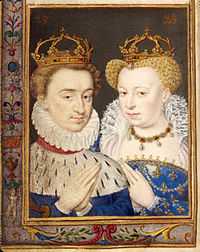
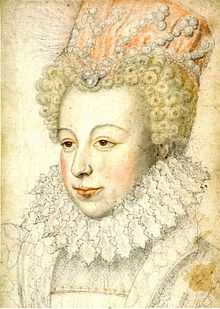
Margaret married King Henry III of Navarre, who ultimately succeeded to her brothers as Henry IV of France (from this marriage, she was also the Duchess of Vendôme), the son of the Protestant queen Jeanne III of Navarre and Antoine de Bourbon, in a union that was designed to reunite family ties (the Bourbons were part of the French Royal family and the closest relatives to the reigning Valois branch) and create harmony between Catholics and the Protestant Huguenots. Henry's mother opposed the marriage, but many of her nobles supported it, so the match was made.
However, Jeanne died under suspicious circumstances before the marriage could take place; some suspected that a pair of gloves sent to Jeanne as a wedding gift from Margaret's mother, Catherine de' Medici, had been poisoned.[4] The marriage of the 19-year-old Margaret to Henry, who had become King of Navarre upon the death of his mother, took place on 18 August 1572 at Notre Dame cathedral in Paris.[5] The groom, a Huguenot, had to remain outside the cathedral during the religious ceremony.[5]
Just six days after the wedding, on St Bartholomew's Day, Roman Catholic factions instigated a targeted group of assassinations, followed by a wave of mob violence, both directed against the Huguenots (French Calvinist Protestants). Traditionally believed to have been instigated by Catherine de' Medici, the marriage was an occasion on which many of the most wealthy and prominent Huguenots had gathered in largely Catholic Paris.
This event took place during the period 1562 to 1598, known as the French Wars of Religion, which consisted of factional disputes between the aristocratic houses of France, such as the House of Bourbon and House of Guise (Lorraine).
After the St Bartholomew's Day massacre
Margaret has been credited with saving the lives of several prominent Protestants, including her husband's, during the massacre, by keeping them in her rooms and refusing to admit the assassins. Henry of Navarre had to feign conversion to Catholicism.
_by_Nicholas_Hilliard.jpg)
After more than three years of confinement at court, Henry escaped Paris in 1576,[5] leaving his wife behind. Finally granted permission to return to her husband in Navarre, for the next three and a half years Margaret and her husband lived in Pau. Both openly kept other lovers, and they quarrelled frequently.
Agen and Usson
After an illness in 1582, Queen Margaret returned to the court of her brother, Henry III, in Paris. But Henry III was soon scandalized by her reputation and forced her to leave the court, even claiming she had a bastard child by Jacques de Harlay. After long negotiations, she was allowed to return to her husband's court in Navarre, but she received an icy reception. Determined to overcome her difficulties, Queen Margaret masterminded a coup d'état and seized power over Agen, one of her appanages. After several months of fortifying the city, the citizens of Agen revolted and Queen Margaret fled to the castle of Carlat. In 1586, she was imprisoned first by her brother Henry III then by her husband Henry IV in the castle of Usson, in Auvergne, where she spent eighteen years first as a state prisoner under her brother then a prisoner in exile under her husband who divorced her.
During this time, Margaret wrote her memoirs consisting of a succession of stories relating to the affairs of her brothers Charles IX and Henry III with her former husband Henry IV. The memoirs were published posthumously in 1628 and scandalised the population.
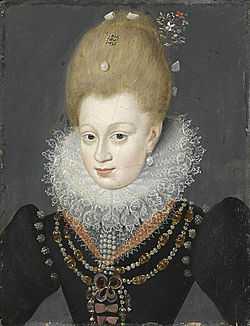
In 1589, Henry, her husband, succeeded to the throne of France as Henry IV. He was, however, not accepted by most of the Catholic population until he converted four years later. Henry continued to keep mistresses, most notably Gabrielle d'Estrées from 1591 to 1599, who bore him four children. Negotiations to annul the marriage were entered in 1592 and concluded in 1599 with an agreement that allowed Margaret to maintain the title of queen.
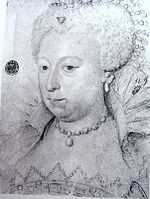
Last years
She settled her household on the Left Bank of the Seine, in the Hostel de la Reyne Margueritte that is illustrated in Merian's 1615 plan of Paris (illustration); the hostel was built for her to designs by Jean Bullant in 1609. It was eventually demolished and partially replaced in 1640 by the Hôtel de La Rochefoucauld.[6]
Reconciled to her former husband and his second wife, Marie de' Medici, Queen Margaret returned to Paris and established herself as a mentor of the arts and benefactress of the poor. She often helped plan events at court and nurtured the children of Henry IV and Marie.
Margaret died in her Hostel de la Reyne Margueritte, on 27 March 1615, and was buried in the funerary chapel of the Valois in the Basilica of St. Denis.[7] Her casket has disappeared and it is not known whether it was removed and transferred when work was done at the chapel, or destroyed during the French Revolution.[8]
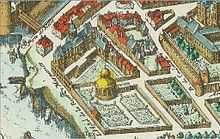
Margaret of Valois in literature & fiction
Alexandre Dumas, père's 1845 novel La Reine Margot is a fictionalised account of the events surrounding Margaret's marriage to Henry of Navarre. The novel was adapted into a 1994 French film, La Reine Margot, in which the role of Margaret was played by the popular French actress Isabelle Adjani. The main action of Shakespeare's early comedy Love's Labour's Lost (1594–5) is based on an attempt at reconciliation, made in 1578, between Margaret and Henry.
Margaret is portrayed by Constance Talmadge in D.W. Griffith's 1916 film Intolerance.
La Reine Margot appears in Jean Plaidy's novel, Myself, My Enemy a fictional memoir of Queen Henrietta Maria, consort of King Charles I of England. A chance meeting between the young princesse Henriette and the elderly reine Margot at the celebration of marriage of Henriette's brother, Louis XIII of France, and Anne of Austria, hints to the reader about the fascinating character that Margaret of Valois was. She also features in Jean Plaidy's 'Medici' Trilogy which focuses on her mother, Catherine de Medici - mostly in the second book "The Italian Woman".
Margaret of Valois also has a major role in the Meyerbeer opera Les Huguenots. This was one of Joan Sutherland's signature roles and she performed it for her farewell performance for the Australian Opera in 1990.
| Styles of Queen Margaret of France as consort | |
|---|---|
| Reference style | Her Majesty |
| Spoken style | Your Majesty |
| Alternative style | Madame |
Ancestry
| Ancestors of Margaret of France (1553–1615) | ||||||||||||||||||||||||||||||||||||||||||||||||||||||||||||||||||||||||||||||||||||||||||||||||||||||||||||||||||||||||||||||||||||||||||||||||||||||||||||||||||||||||||||||||||||||||||||||||||||||||||||||||||||||||||||||||||||||||||||||||||||||||||||||||||||||||||||||||||||||||||||||||||||||||||||||||||||||||||||||||||||||||||||||||||||||||||||||||||||||||||||||||||||||||||||||||||||||||||||||||||||||||||||||||||||||||||||||||||||||||||||||||||||||||||||||||||||||||||||||||||||||||||||||||||||||||||||||||||
|---|---|---|---|---|---|---|---|---|---|---|---|---|---|---|---|---|---|---|---|---|---|---|---|---|---|---|---|---|---|---|---|---|---|---|---|---|---|---|---|---|---|---|---|---|---|---|---|---|---|---|---|---|---|---|---|---|---|---|---|---|---|---|---|---|---|---|---|---|---|---|---|---|---|---|---|---|---|---|---|---|---|---|---|---|---|---|---|---|---|---|---|---|---|---|---|---|---|---|---|---|---|---|---|---|---|---|---|---|---|---|---|---|---|---|---|---|---|---|---|---|---|---|---|---|---|---|---|---|---|---|---|---|---|---|---|---|---|---|---|---|---|---|---|---|---|---|---|---|---|---|---|---|---|---|---|---|---|---|---|---|---|---|---|---|---|---|---|---|---|---|---|---|---|---|---|---|---|---|---|---|---|---|---|---|---|---|---|---|---|---|---|---|---|---|---|---|---|---|---|---|---|---|---|---|---|---|---|---|---|---|---|---|---|---|---|---|---|---|---|---|---|---|---|---|---|---|---|---|---|---|---|---|---|---|---|---|---|---|---|---|---|---|---|---|---|---|---|---|---|---|---|---|---|---|---|---|---|---|---|---|---|---|---|---|---|---|---|---|---|---|---|---|---|---|---|---|---|---|---|---|---|---|---|---|---|---|---|---|---|---|---|---|---|---|---|---|---|---|---|---|---|---|---|---|---|---|---|---|---|---|---|---|---|---|---|---|---|---|---|---|---|---|---|---|---|---|---|---|---|---|---|---|---|---|---|---|---|---|---|---|---|---|---|---|---|---|---|---|---|---|---|---|---|---|---|---|---|---|---|---|---|---|---|---|---|---|---|---|---|---|---|---|---|---|---|---|---|---|---|---|---|---|---|---|---|---|---|---|---|---|---|---|---|---|---|---|---|---|---|---|---|---|---|---|---|---|---|---|---|---|---|---|---|---|---|---|---|---|---|---|---|---|---|---|---|---|---|---|---|---|---|---|---|---|---|---|---|---|---|---|---|---|---|---|---|---|---|---|---|---|---|---|---|---|---|---|---|---|---|---|---|---|---|---|---|---|---|---|---|---|---|---|---|---|---|---|---|---|---|---|---|---|---|---|---|---|---|---|---|---|---|---|---|---|---|---|---|---|---|---|---|---|---|---|---|---|---|---|---|---|---|---|---|---|
| ||||||||||||||||||||||||||||||||||||||||||||||||||||||||||||||||||||||||||||||||||||||||||||||||||||||||||||||||||||||||||||||||||||||||||||||||||||||||||||||||||||||||||||||||||||||||||||||||||||||||||||||||||||||||||||||||||||||||||||||||||||||||||||||||||||||||||||||||||||||||||||||||||||||||||||||||||||||||||||||||||||||||||||||||||||||||||||||||||||||||||||||||||||||||||||||||||||||||||||||||||||||||||||||||||||||||||||||||||||||||||||||||||||||||||||||||||||||||||||||||||||||||||||||||||||||||||||||||||
See also
References
- ↑ 1.0 1.1 1.2 Kathleen Wellman, Queens and Mistresses of Renaissance France, (Yale University Press, 2013), 277.
- ↑ 2.0 2.1 R.J. Knecht, The French Wars of Religion, 1559-1598, (Longman Inc., 1989), 39.
- ↑ 3.0 3.1 Kathleen Wellman, Queens and Mistresses of Renaissance France, 280.
- ↑ R.J. Knecht, Catherine de' Medici, (Pearson Education Limited, 1999), 151.
- ↑ 5.0 5.1 5.2 R.J. Knecht, Catherine de' Medici, 153.
- ↑ "Histoire de la rue par les cartes"
- ↑ Castarède, Jean, La triple vie de la reine Margot, Éditions France-Empire, Paris, 1992, pp. 236-7, ISBN 2-7048-0708-6
- ↑ Jean Castarède, p. 237
External links
-
 Media related to Marguerite de Valois at Wikimedia Commons
Media related to Marguerite de Valois at Wikimedia Commons - Works by Margaret of France at Project Gutenberg
- Works by or about Margaret of France at Internet Archive
- Memoirs of Marguerite de Valois (in English):
- New York, Charles Scribners, 1892, translated by Violet Fane. View at Google Books .
- Boston, L. C. Page, 1899 . Vew at Project Gutenberg or Google Books .
- Image at cybersybils.net
- Image at pandemonium.tiscali.de
| French royalty | ||
|---|---|---|
| Preceded by Marguerite de Navarre |
Queen consort of Navarre 1572–1599 |
Succeeded by Marie de' Medici |
| Preceded by Louise of Lorraine |
Queen consort of France 1589–1599 | |